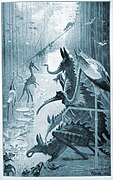Extraterrestrial life, or alien life, is life that originates from another world rather than on Earth. No extraterrestrial life has yet been scientifically conclusively detected. Such life might range from simple forms such as prokaryotes to intelligent beings, possibly bringing forth civilizations that might be far more advanced than humans. The Drake equation speculates about the existence of sapient life elsewhere in the universe. The science of extraterrestrial life is known as astrobiology.

Mars, the fourth planet from the Sun, has appeared as a setting in works of fiction since at least the mid-1600s. Trends in the planet's portrayal have largely been influenced by advances in planetary science. It became the most popular celestial object in fiction in the late 1800s, when it became clear that there was no life on the Moon. The predominant genre depicting Mars at the time was utopian fiction. Around the same time, the mistaken belief that there are canals on Mars emerged and made its way into fiction, popularized by Percival Lowell's speculations of an ancient civilization having constructed them. The War of the Worlds, H. G. Wells's novel about an alien invasion of Earth by sinister Martians, was published in 1897 and went on to have a major influence on the science fiction genre.

Percival Lowell was an American businessman, author, mathematician, and astronomer who fueled speculation that there were canals on Mars, and furthered theories of a ninth planet within the Solar System. He founded the Lowell Observatory in Flagstaff, Arizona, and formed the beginning of the effort that led to the discovery of Pluto 14 years after his death.
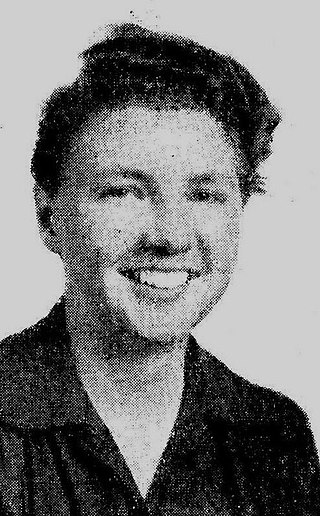
Leigh Douglass Brackett was an American author and screenwriter. Nicknamed "the Queen of Space Opera," she was one of the most prominent female writers during the Golden Age of Science Fiction. As a screenwriter, she was best known for her collaborations with director Howard Hawks, mainly writing Westerns and crime films. She also worked on an early draft of The Empire Strikes Back (1980), elements of which remained in the film; she died before it went into production.

Red Planet is a 1949 science fiction novel by Robert A. Heinlein about students at boarding school on the planet Mars. It represents the first appearance of Heinlein's idealized Martian elder race. The version published in 1949 featured a number of changes forced on Heinlein by Scribner's, since it was published as part of the Heinlein juveniles. After Heinlein's death, the book was reissued by Del Rey Books as the author originally intended.
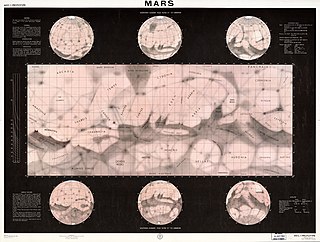
During the late 19th and early 20th centuries, it was erroneously believed that there were "canals" on the planet Mars. These were a network of long straight lines in the equatorial regions from 60° north to 60° south latitude on Mars, observed by astronomers using early telescopes without photography.

A Princess of Mars is a science fantasy novel by American writer Edgar Rice Burroughs, the first of his Barsoom series. It was first serialized in the pulp magazine All-Story Magazine from February–July, 1912. Full of swordplay and daring feats, the novel is considered a classic example of 20th-century pulp fiction. It is also a seminal instance of the planetary romance, a subgenre of science fantasy that became highly popular in the decades following its publication. Its early chapters also contain elements of the Western. The story is set on Mars, imagined as a dying planet with a harsh desert environment. This vision of Mars was based on the work of the astronomer Percival Lowell, whose ideas were widely popularized in the late 19th and early 20th centuries.

Two Planets is an influential science fiction novel postulating intelligent life on Mars by Kurd Lasswitz. It was first published in hardcover by Felber in two volumes in 1897; there have been many editions since, including abridgements by the author's son Erich Lasswitz and Burckhardt Kiegeland and Martin Molitor. The 1948 abridgement, with "incidental parts" of the text taken from the 1969 version, was the basis of the first translation into English by Hans H. Rudnick, published in hardcover by Southern Illinois University Press in 1971. A paperback edition followed from Popular Library in 1976. The story covers topics like colonization, mutually assured destruction and clash of civilizations many generations before these topics came into politics.
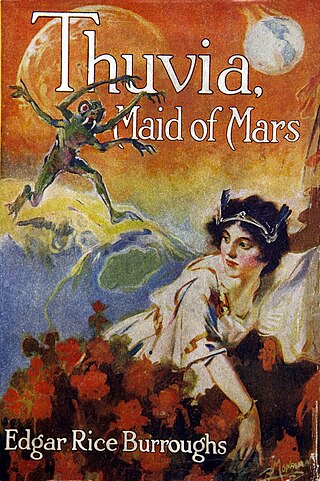
Thuvia, Maid of Mars is a science fantasy novel by American writer Edgar Rice Burroughs, the fourth of the Barsoom series. The principal characters are Carthoris and Thuvia of Ptarth, each of whom appeared in the previous two novels.

The planet Venus has been used as a setting in fiction since before the 19th century. Its opaque cloud cover gave science fiction writers free rein to speculate on conditions at its surface—a "cosmic Rorschach test", in the words of science fiction author Stephen L. Gillett. The planet was often depicted as warmer than Earth but still habitable by humans. Depictions of Venus as a lush, verdant paradise, an oceanic planet, or fetid swampland, often inhabited by dinosaur-like beasts or other monsters, became common in early pulp science fiction, particularly between the 1930s and 1950s. Some other stories portrayed it as a desert, or invented more exotic settings. The absence of a common vision resulted in Venus not developing a coherent fictional mythology, in contrast to the image of Mars in fiction.

The Warlord of Mars is a science fantasy novel by American writer Edgar Rice Burroughs, the third of his Barsoom series. Burroughs began writing it in June, 1913, going through five working titles; Yellow Men of Barsoom, The Fighting Prince of Mars, Across Savage Mars, The Prince of Helium, and The War Lord of Mars.

Edison's Conquest of Mars is an 1898 science fiction novel by American astronomer and writer Garrett P. Serviss. It was written as a sequel to Fighters from Mars, an unauthorized and heavily altered version of H. G. Wells's 1897 story The War of the Worlds. It has a place in the history of science fiction for its early employment of themes and motifs that later became staples of the genre.

Barsoom is a fictional representation of the planet Mars created by American pulp fiction author Edgar Rice Burroughs. The first Barsoom tale was serialized as Under the Moons of Mars in pulp magazine The All-Story from February to July 1912 and published compiled as a novel as A Princess of Mars in 1917. It features John Carter, a late-19th-century American Confederate veteran who is mysteriously transported from Earth to the dying world of Mars where he meets and romances the beautiful Martian princess Dejah Thoris. Ten sequels followed over the next three decades, further extending his vision of Barsoom and adding other characters.
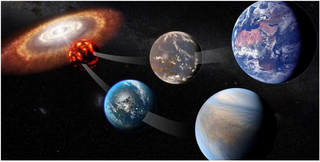
An Earth analog, also called an Earth analogue, Earth twin, or second Earth, is a planet or moon with environmental conditions similar to those found on Earth. The term Earth-like planet is also used, but this term may refer to any terrestrial planet.
William Robinson Leigh was an American artist and illustrator, who was known for his painted Western scenes.

The War of the Worlds is a science fiction novel by English author H. G. Wells. It was written between 1895 and 1897, and serialised in Pearson's Magazine in the UK and Cosmopolitan magazine in the US in 1897. The full novel was first published in hardcover in 1898 by William Heinemann. The War of the Worlds is one of the earliest stories to detail a conflict between humankind and an extraterrestrial race. The novel is the first-person narrative of an unnamed protagonist in Surrey and his younger brother who escapes to Tillingham in Essex as London and Southern England are invaded by Martians. It is one of the most commented-on works in the science fiction canon.
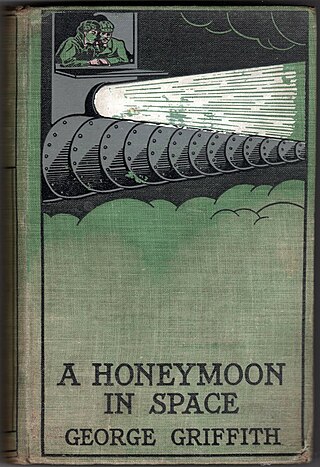
A Honeymoon in Space is a 1901 novel by George Griffith. It was originally serialized in abridged form in Pearson's Magazine in 1900 under the title Stories of Other Worlds. The scientific romance story depicts a tour of the Solar System, a type of story that was in vogue at the time.

Imagining Mars: A Literary History is a 2011 non-fiction book by science fiction scholar Robert Crossley. The book chronicles the history of Mars in fiction, and to a lesser extent in culture. The overarching thesis of the work is that the scientific understanding of Mars and the versions of the planet imagined in works of fiction have developed in parallel and influenced each other. It covers a timeframe spanning from the pre-telescope era up to the present day, especially the time period after 1877. Particular attention is paid to the influence of amateur astronomer Percival Lowell (1855–1916), who popularized the myth of Martian canals in the public consciousness, and science fiction author H. G. Wells (1866–1946) who wrote the seminal 1897 novel The War of the Worlds. The book charts how the depiction of Mars changed throughout the second half of the 1900s in response to successive advances in planetary science, while noting that some authors preferred to continue portraying the planet in a nostalgic way that was by then scientifically outdated.
Is Mars Habitable? A Critical Examination of Professor Percival Lowell's Book "Mars and Its Canals," with an Alternative Explanation is a 1907 non-fiction book by British naturalist Alfred Russel Wallace (1823–1913). The work is a followup to his previous work, Man's Place in the Universe (1903), which initially explored the potential for extraterrestrial life. Is Mars Habitable? follows a similar theme, but is more of a reply and refutation of the book Mars and Its Canals (1906) by astronomer Percival Lowell. Lowell famously argued that an advanced, intelligent civilization engineered Martian canals on the surface of the planet, a now-discredited idea. Wallace's book evaluates Lowell's theory, eventually concluding that Mars "is not only uninhabited by intelligent beings such as Mr. Lowell postulates, but is absolutely uninhabitable", a conclusion Wallace had already reached in Man's Place in the Universe. Historian Charles H. Smith refers to Wallace's book as one of the first works in the field of astrobiology.



